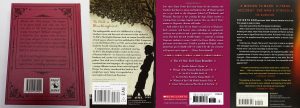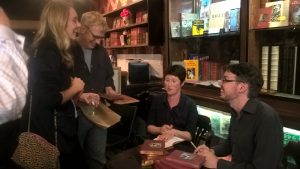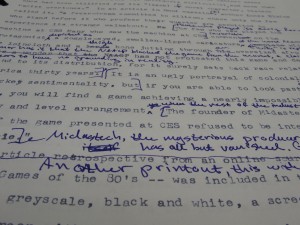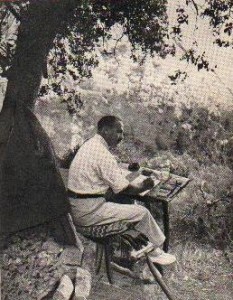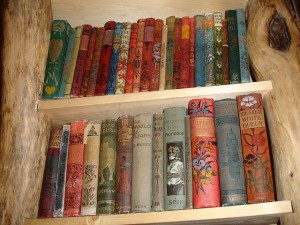Posts by Sophie Masson
Does it even exist, that perfect enticement to readers, that perfect pearl of a teaser which makes you instantly go to the counter and hand over your hard-earned cash? Perhaps not…but chances are that as an author—whether traditionally or self-published, whether this is your first or your fiftieth book—you’ll have to create, or help create, a back cover blurb for each of your books. And it’s something that in my experience takes some time—as you have to distill quite a few elements to make a sparkling blurb cocktail!
What exactly are those elements? Speaking both as a reader and a writer, for me a good back cover blurb includes:
Optional (but good to have at least one):
Also, style-wise, a good blurb should be:
Read MoreHappy authors, happy audience: at an Eagle Books launch earlier this year
As co-director of a small press publisher, Christmas Press, and its associated imprints, Eagle Books and Second Look, November is a busy month for me. We have three book events scheduled, two being a launch for the same new book on two different days in two different cities and the other being a re-celebration, in a different city, of a book published (and launched) earlier this year. In the weeks and months leading up to the events, I nailed down the details; venues, publicity, making sure authors can come, and ensuring that the books would be available at the various venues. This is easy when it’s being held in a bookshop, as one event is, but not so simple when they are held in other places. It’s certainly not the first time that I’ve run such events, both as publisher and as author, and it’s pleasing to know that they have generally been very successful. It struck me that perhaps WU readers might be interested in some of my tips on planning book events.
If it’s a launch, think carefully. I know most of us authors love a good book launch but not every book needs to be launched—and wearing my publisher hat, I understand why publishers can be reticent about that! For a start, it’s a lot of work, it costs money, and your supporters can get launch fatigue if you do launches too often. Launches are especially good for debut books; for bespoke, collectible books; and for group books, such as anthologies and collections. In each of those three cases you are pretty much guaranteed to get a good crowd, as friends and family flock to the debut author’s event, connoisseurs and special-interest people get fired up over owning their own signed copy of a collectible book, and contributors to anthologies and collections can be relied on to turn up to celebrate their group effort, bringing their own supporters with them. Don’t get me wrong: I’m not saying that other types of book launches don’t work. They certainly can, but you’ll need to put in extra work and imagination if the launch is for say your fifth or tenth or twentieth book—unless of course you are a bestselling author for whom crowds will always come no matter what!
Read Morephoto by Sophie Masson
A couple of weeks ago, I was in an extraordinary place: Rotorua in New Zealand, where bubbling mud pools, shooting geysers and steam-wreathed villages create an amazing otherworldly atmosphere, complete with sound effects (gurgle, hiss, splash) and smell (rotten eggs, burnt toast). It’s a place full of stories, of course: Maori legends, tales of historical tragedies, love stories and scary stories…A place to fire the imagination! And one which could be a living example of the idea that setting does not have to be just a backdrop to story, but almost a character in itself.
It’s easy to see that in Rotorua, where the bubbling mud seems ready at any moment to spew out a strange creature, the very hot springs sometimes called murder ripples have a weirdly placid beauty under their clouds of steam, and the fires of the earth’s center are much closer to the surface than is truly comfortable to think about for too long. Here, a writer can–and in my case, does–file away verbal and written impressions as well as photos and videos to help in the creation of a fictional setting that won’t be actually Rotorua, but will be greatly inspired by it. And like the real place, it will be more than just a backdrop.
That kind of real-world setting, which in its extraordinary distinctiveness can seem almost fictional (as, in a contrasting but complementary example, a city like Venice, which I’ve also used in my fiction, does as well) might seem like an easy way into creation of a fictional world. After all, how hard can it be to take elements like boiling mud and clouds of steam and sleeping volcanoes—or gondolas and bridges and golden-domed palaces–and fictionalize them? Don’t all you need to do is simply faithfully transcribe what your senses tell you?
Newsflash: What must be believed in real life because you see it (and smell it!) in front of your nose is not so obvious when you’re dealing with fiction. You have to work at it to make your reader believe, even when you’re departing from a real-world setting as atmospheric as Rotorua or Venice, and even–or perhaps especially–when you are creating fantasy fiction. So how do you do it? What do you leave in, and what do you leave out?
Here’s my advice, based on some of the things I’ve learned over the years:
Read MoreFlickr Creative Commons: Andy Lamb
In my last WU post, I wrote about the building blocks of great YA fiction, and in the post before that, I wrote about writing picture books for the youngest readers. This time, I’m looking at an in-between age range: what’s known as ‘middle-grade’.
First of all, a definition: what exactly is meant by ‘middle-grade’? At its most basic, it means books for readers aged 8-12, or 9-13. These are the books you read after you become a fluent reader, and before you start to tackle YA fiction. It’s what you might call the golden age of reading, where you find the most readers—I would say the most readers of any age, including adults. But what works for an 8 or 9 year old might not work so well for a 12 or 13 year old—and vice versa–so within that broad category of middle grade, there are sub-categories of lower and upper middle-grade (sometimes the upper end is also referred to as ‘tweens’).
The age of the readership however is only a guide. There are other things involved in knowing whether your manuscript is ‘middle grade’ or should shift upwards into ‘YA.’ I’ve written a lot of middle grade fiction as well as YA—and in all kinds of genres, from fantasy to historical to mystery to contemporary to humor—and can personally testify to the fact that it’s certainly not genre that separates middle-grade books from books aimed at young adult readers. It’s an alchemy of elements that in any genre of middle grade makes you know that a story is for readers of that age, rather than their older siblings–or indeed their younger ones—what’s known, at least in my home country of Australia, as ‘junior fiction’, is for kids aged 5-8, new readers who are ready to venture into short ‘chapter books’.
So how can you tell if your manuscript is for middle grade?
Read More
In my last post, I talked about writing texts for the youngest readers: picture books. Today, I want to look at the other end of the scale of fiction for young people: writing YA, or Young Adult, fiction.
YA fiction is flourishing right now, with many of the top-selling books in that field–for adults as well as teenagers love to read YA–and publishers are actively looking for great manuscripts. What kinds of books are they looking for? From my observation, these genres seem to be ‘hot’ right now in YA fiction:
Contemporary realism: Confronting hard-hitting issues with emotion but also a light touch
Fantasy: But not vampires or shape-shifters or angels or dystopias unless these are ‘High concept’—ie a dramatic scenario that has not been tackled before or is substantially different in treatment from what’s been done before. Fantasy also should be centered more on strong development of character than too much world-building.
Historical with an adventure/mystery/spy twist.
Thrillers: Mixed genres are popular, such as thrillers crossed with science fiction, or history
Humor: Always a winner: but perhaps the hardest thing of all to write!
Don’t despair if none of those are your bag. Publishers are looking, more than anything, for what they have always looked for: surprising, well-written, gripping stories with great characters and a fresh and interesting voice. Stories that feel like there’s passion behind them: the writer’s passion.
Okay, so that’s the market. But what exactly, from a writer’s craft point of view, are the actual building blocks of great YA fiction, without which every ‘high concept’ would not work? Over the years, I’ve had many YA novels published, from historical to contemporary, realism to fantasy and romance to thriller. And over those years, I’ve come to clarify just what it is, to me, that makes a story resonate with readers of YA fiction, so I’d like to share that with you.
Read MoreFlickr Creative Commons: Carol VanHook
Recently, to my great delight, two of my short, original picture book texts have been accepted for publication: one, Two Rainbows, is about a farm child who’s moved to the city; and the other, Once Upon An Abc, is a quirky ABC book based on folk and fairy tale characters from around the world. Several other texts are out with publishers at the moment, so we’ll see what happens with them. It certainly seems that this particular way of writing, which I’ve dreamed about doing for years, has, like the children’s poetry I wrote about in an earlier post, suddenly clicked for me.
A little history: My first picture book, Two Trickster Tales from Russia, was actually published in 2013, but it’s a different kind of text from the others I mentioned, as it’s re-tellings of two traditional Russian stories. Another story, original this time, was published in a lovely illustrated multi-author and illustrator book, Three Dragons for Christmas, last year.
My focus in this post, however, is on the ‘classic’ picture book format: one original text by one author, illustrated by one illustrator, within a 32-page book. Writing one of these texts necessitates learning a whole other way of approaching writing. It’s been a delight, learning that, but also a challenge at times!
So I thought I’d pass on some of the things I’ve learned over the last couple of years as I’ve worked on several texts—some of which worked, others of which didn’t and were discarded—or left aside for a while and reworked.
Read More
Scenario 1: You’re a writer whose first book is about to be published, and you’ve been inundated with requests for interviews. In the dim and distant days before blogs and online magazines, that meant someone calling you, or goodness, even coming to visit you in person and recording the interview on a little machine. These days, though, the approach is usually made through email, and unless it’s a piece for your local paper (and even then perhaps!) the interview will most likely be conducted in the same medium, and published online. It’s likely you will never meet the interviewer and so you have to impress and interest them purely through the written word. Well, that’s easy, isn’t it? You are a writer after all! And then you get that first interview-and you freeze. Talking too much—or not enough—revealing too much—or revealing too little—striking the right tone—treading a fine line between spontaneity and reflection—showing confidence but not being too pushy: so many things to think about, so much to get right (or wrong).
Scenario 2: You’re a writer, published or unpublished, and you have a blog. You’d love to find out more about the work of fellow writers, and what makes them tick. You come up with a great idea: interviews for your blog. You’ve got quite a few writing contacts already, so you can start with them. Compiling author interviews will be easy. You’re a writer, and a reader. You know just how it should go. Then you start compiling your first set of interview questions, and you panic. What if the author thinks the questions are too bland? Too pushy? Too gushing? Or too impersonal? Should you ask about their life outside of their work or leave that strictly alone? So many things to get right (or wrong)
Author interviews are a fact of the writing life. Whether as interviewee or as interviewer, every author will inevitably have to gain some experience of the art and craft of author interviews. So how do you go about getting that experience?
Read MoreNobody writes in isolation. Writers experience mentoring in one way or the other at every stage in their careers. Early writing mentors are usually teachers, family and friends. Later, as we take our first steps towards trying to build a career as a writer, other, more professional mentors can improve our understanding of craft, as well as give us the confidence to take those first tentative steps.
As a young writer who initially saw her potential in poems and short fiction, I first experienced the power of mentor-ship after sending my work to famous Australian poets I’d studied at school. This naive bit of boldness resulted in some memorable responses—all of them generous and kind towards the young writer who had written to distinguished authors out of the blue. Several were helpful in both practical and creative ways. One of them, the eminent poet and literary academic A.D. Hope (pictured) even wrote to me two or three times, giving me extensive advice on several new poems, as well as the addresses of magazines I might send them to. Thus it was that I learned not only ways in which I might improve my craft and where I might send work for publication, but also two other important lessons: how generous and supportive other writers can be, and how important it is to be mentored by authors more skilled and experienced than you are.
That was my first experience of mentoring by writers, but it was not to be the last. By the time my first book was published and I had moved from the informal experience to the more formal framework of ‘mentor-ship’, otherwise known as working with editors in a publishing house, my craft had been improved as well as confidence in my own voice.
Throughout my publishing career, and, like, I’m sure, many other writers, there have been times when I have been part of an informal quid pro quo mentor-ship with writer friends as we read each other’s manuscripts and make suggestions and comments–this is especially useful if you are moving into an unfamiliar genre or trying to work out why something isn’t working for a publisher. Remembering my own experiences, I’ve often informally mentored young and emerging writers, and formally through schools programs. I have also been involved in formal arrangements with adult authors where I have been a paid mentor to new and emerging writers through official mentor-ship programs run by such bodies as the Australian Society of Authors and the various writers’ centres and organisations in this country. (I am sure there are many such similar programs in the USA and other countries).
Through all these experiences, both of being a mentor and a mentee, I’ve learned not only that trust is the essential ingredient on both sides, but also gained a wider understanding of the elements that make a successful mentor-ship experience, and what elements can make it fail. Here’s some of them, from both sides of the fence. They are especially applicable to formal, paid mentor-ships, but are also relevant to more informal arrangements.
Read MoreBrowsing on the internet one day, looking up Conan Doyle sites with the vague notion of Sherlock Holmes appearing in a detective novel for young readers I was planning, I stumbled across a casual reference to a certain H. Ashton-Wolfe. Ashton-Wolfe was a writer of true-crime adventure bestsellers, who claimed to know not only Holmes’ creator, as well as the leading lights of the French Sûreté and Scotland Yard, but also just about every famous criminal and outlaw of the day!
Several hurried orders from online used bookshops later, I had built a mini-library of Ashton-Wolfe’s books, with their gorgeously pulpy titles, such as Crimes of Love and Hate, The Thrill of Evil, Outlaws of Modern Days, and The Forgotten Clue. I plunged into the addictive joys not only of the melodramatic and exotic cases recounted in racy prose, but the vain and boastful character of Ashton-Wolfe himself, which infused the stories with unintentional hilarity. So engaging was this combination that I immediately dropped Sherlock in favor of a certain Philip Woodley-Foxe, whose adventures are legendary, not least to himself. You can find him in my mystery novel for young people, The Case of the Diamond Shadow. No prizes for guessing who he was based on!
A marvelous combination of Action Man, cheerleader for “modern” scientific detection, adventurous master of disguise and shameless name-dropper, Harry Ashton-Wolfe doesn’t just recount the cases, he inhabits them. He’s an important part of investigating teams in Paris tracking down fiendishly cunning criminals; he gets locked up and threatened with death by vicious gangsters; he is at the elbow of the greatest forensic scientists of the day; he is allowed to peruse the ”secret archives” of the Paris Prefecture; by chance, he dons disguises such as that of a Parisian Apache or a Corsican bandit to infiltrate criminal rings.
For me, finding the books of this long-forgotten true-crime celebrity writer was like being given a key to unlock my own fictional world. Once I had it, it was like everything else fell into place–characters, setting, atmosphere. I collected many old true-crime magazines as well, but it was Harry Ashton-Wolfe and the inspiration born through discovering his work and persona that gave my own project its zing and verve–much better than using Sherlock Holmes would have done.
It’s just one example of that wonderful serendipity we writers can experience in used-book stores, whether classic bricks-and-mortar or the amazing virtual used-book emporiums on the internet. Many’s the time I’ve just been browsing casually and fallen on something that has sparked a new train of thought–whether that’s in the creation of a new character, the germ of an idea, or a solution to a writing problem. […]
Read MoreRecently I was approached by the people from Masterclass, a brand new online learning hub which features courses in different areas of the arts and sport, taught by world-famous masters of their craft–such as Dustin Hoffman for acting, Serena Williams for tennis–and James Patterson for writing. Masterclass asked if, as an experienced author, I’d be interested in checking out the course and seeing what I thought. I did some research, discovering Masterclass to be a start-up based in San Francisco that had debuted in May this year and that it was themed around the concept that some masters in their field are also great teachers, and love to impart the knowledge and experience they’ve gained. I liked the idea and was also, I admit, curious to hear what the world’s highest-selling author had to say about his ways of working, so using the gift code provided, (the whole course costs $90 US normally, which seems very reasonable considering what you get) I set up my account, logged in and began exploring.
First of all, I want to write about how the course is structured, and then move to a discussion of whether it works, and for whom. There are four parts to the course: firstly a series of 22 videos in which James Patterson talks about different aspects of the craft of creating fiction: raw ideas; plot; creating characters; successful outlines; research; writing dialogue; building chapters, how to write good endings, editing, and much more, through to post-creation issues such as titles, marketing–and of course getting published! There are also a few more personal themed-videos: one where the author recounts his own personal journey to publication and success; one where he rather amusingly recounts his brushes with Hollywood; and one on the experience of working with co-authors. The videos vary in length between 3 and 14 minutes, depending on the complexity of the theme, and all of them feature James Patterson talking directly to the camera, in a chatty, conversational style, truffled with anecdotes, examples, tips and pithy sayings (a favourite of mine: Passion and habit are key to a successful writing career). Secondly, there is a 72 page downloadable and printable workbook which is designed to complement and expand the videos, recapping on each theme, and providing practical exercises for students to complete on their own. The workbooks come in two versions: one which includes the very comprehensive outline Patterson wrote for his novel Honeymoon (which can be used in assignments) and one without the Honeymoon outline. Thirdly, there is a section called ‘Office Hours’ where the author answers questions video-recorded or written in by students (of course these are selected as otherwise it would be all too easy to become overwhelmed). Within this section also is a series of video critiques by Patterson looking at selected class assignments and how students have handled them–for example, he looks at a whole lot of potential book titles that have been sent in, and says whether he thinks they work, and why they do or don’t. Finally, there is a discussion facility on each theme, where students can interact with each other based initially on a moderator’s discussion question (he’s called a […]
Read MoreThe changes in the publishing industry in recent times can seem really daunting and, like most writers, there are times when I’ve thought dark thoughts about just what the future might hold. But if there are many challenges in the new landscape of publishing, there are also great new opportunities. The rise of self-publishing is one of those opportunities that has been discussed at length, but another that hasn’t been quite so prominently discussed is the fact that the fall in printing prices caused by the advent of digital-based typesetting, design and proofs, as well as new methods of raising money, such as crowdfunding, has meant also a rise in small presses: people, sometimes authors and artists, sometimes not, following their passion and taking on publishing projects that in the past would simply have seemed like a pipe-dream. For me, one of those dreams is actually coming true: being actively involved in reintroducing to English-speaking readers a classic French novel that was one of the great books of my own life.
As a French-speaking child living in both Australia and France, Jules Verne’s great adventure novel Michel Strogoff was my favourite book in the world when I was around 12. The book was enormously influential on me, both as a reader and a writer, leading to a lifelong fascination with Russia and a lifelong love of both reading and writing adventure fiction. I’ve re-read the book many times over since then and love it just as much. An epic chase novel set in Tsarist Russia, it’s also beautifully written. With its mix of vivid characters (including, unusually for Verne, strong and interesting female characters), cracking pace, colourful settings, non-stop action, adventure and suspense, leavened by deft touches of romance and humour, it’s reckoned in France to be Jules Verne’s best novel, and not only has it never been out of print, it’s also inspired dozens of film and TV adaptations.
But it always frustrated me that when I mentioned it to English-language friends, they had never heard of it because the only English translation had been done back when the original French edition was first published. That translation was very much of its time, and in my opinion did not capture the liveliness and freshness of the French original, as 19th century popular French novels are much more ‘immediate,’ pacey, and less densely wordy than was the prevailing literary taste in 19th century English-language novels. ‘Michael Strogoff’ as it was titled in English, had been popular in its day—indeed, in the US it was popular enough for not only the first film ever of the book to be made there, in 1914, but also for a small town in Texas to be named after one of its main characters, Strogoff’s tough and indomitable mother, Marfa.
But the translation had dated quite badly and by the time I was growing up, the novel had fallen out of favour in English speaking countries, though in France its enormous influence continued unabated. There, not only writers speak of […]
Read MoreThe idea that you can only write from the viewpoint of your own age group, background, sex, species, or even experiences, seemed absurd and restrictive to me even as a kid. What room was there for imagination in that? Ignoring this whole notion, I shape-shifted with gusto, writing stories from a multitude of viewpoints, from twin detectives to enchanted frogs, princesses to ghosts, mighty warriors to globe-trotting postage stamps(really!) There was no limit, as far as I was concerned.
Now, though I might have grown up and learned a good deal more about writing, my hackles still rise at the idea that because of my physical self, my imaginative self can’t shape-shift. If I feel like writing from the viewpoint of a teenage boy, exiled princess, betrayed soldier, werewolf girl, hunted criminal, spellbound artist or war correspondent, then damnit, that’s just what I’m going to do—and in fact have done. And apparently successfully, judging from the reactions of my readers.
Nobody seriously asks how you can possibly write from the viewpoint of say, a werewolf, a sorcerer, or a ghost. It’s just assumed the imagination takes over. But when it comes to gender, well-meaning people can sound as though they think it’s a far greater stretch. The idea that a female writer can write from a male viewpoint, successfully, is not as hotly contested as the reverse, but it still hovers there.
I thought it might be interesting, rather than just talking in generalities, to look at a couple of my own actual experiences of writing from the viewpoint of a male character: in my recent adult novel, Trinity: The Koldun Code, and in my recent YA novel, The Crystal Heart. In each of these books, the story is told in alternating points of view, one a female character’s viewpoint, one a male.
Read MoreIn my previous post, I wrote about how my first adult novel in thirteen years had been recently published. Since then, I’ve been observing first-hand just how much the literary landscape has changed for genre fiction writers since my last adult novel came out, in 2001. Some of these changes have surprised me, and not because I’ve been out of the publishing scene for 13 years; I’ve been right in it all along, only in the area of YA and children’s fiction, and that by comparison has not changed quite as much (though it certainly has not stood still either). But there are things within the world of publishing for children and young adults which to some extent quarantines it from some of the more extreme or challenging changes. I’ve been aware of what’s been going on in the world of adult fiction, but to experience it firsthand is something else — like a leap into a new world. This has led me to think about just what a difference thirteen years have made, and what these changes are.
Changes in format and timing. In publishing for young people, the ebook has scarcely had an impact. Print still dominates there. But in adult fiction, the rise of the ebook, particularly in genre fiction, has meant an explosion in the numbers of books published. More risks can be taken with ebooks, and so books may have more of a chance at publication. As well, indie authors now compete to some extent with commercial publishers (though not exactly in fair combat). For commercial publishers, it means they’ve had to adjust schedules, previous ideas of marketing, readership and relationship with authors. It’s been great to see my book (first published as an ebook, then as a POD) take shape so quickly, from contract in June to editing and design in September and release in November. That did not happen with my previous adult novel—indeed not with most of my novels for young people, even this year’s crop. Getting the book quickly on the market is certainly a great advantage. However, the low price of ebooks means that achieving the kinds of royalty payments you’d get on a print book is just that much harder and the lack of advances from most digital publishers is another challenge. And that huge and continuing flow of new ebooks is another major challenge. Discoverability is, it seems, more difficult in many ways, though there is the compensation that an ebook’s ‘shelf ‘ life is potentially not as short as a new print novel appearing on a bookshop shelf where it might only have a few weeks to have any kind of impact before it’s returned to the publisher to languish in a warehouse before being remaindered.
Changes in marketing.
Read MoreThis week, my new adult novel, first in a big new series called Trinity, is coming out.
I’m going to be celebrating even more than usual, because this one’s had a long hard road to publication, with nearly four years and several rejections before it was accepted. Even though I’m a well-established author with many books to my name, it looked like this one was fated to remain homeless. ‘Too different’ seemed to be the verdict. A mix of urban fantasy, romance and conspiracy thriller, set in modern Russia, it was outside of my usual genre of YA fiction, and clearly also outside the comfort zone of many publishers.
But I was unwilling to give up.
I really believed in this book. Writing it had been a challenging, enriching and extraordinary experience and its characters and world haunted me.
It was a risky book to write, in all sorts of ways, but deeply thrilling, and I knew there were readers out there who would love it like I did. So I hung on, and in between writing other books, I kept revisiting the novel.
I sent it to good friends who are also writers and listened carefully to their advice and suggestions, and was greatly heartened by the fact they were immediately gripped by the story. I refined it, sculpted it, trying to re-read it with fresh eyes. When we went back to Russia the second time, in 2012, (this time, knowing enough Russian to keep up basic conversations) I rewrote entire paragraphs and even chapters, folding in new impressions of the country and culture into it, waiting for the right moment to send it out once again.
And then that moment came, and so did the right publisher. Joel Naoum of Momentum Books read it, loved it, and ‘got it’ immediately. It was such a thrill, reading his email about my ‘amazing manuscript’ , talking to him in detail about it, and later, meeting the rest of the Momentum team who clearly loved the book, and the idea of the series, as much as he did.
I’ve had a lot of acceptances over the twenty-four years I’ve been a published author, with more than sixty books to my name. And every book is special to me. But this one feels especially sweet, and sitting at my desk writing the sequel as I wait for the first book’s release, I am filled with deep satisfaction. Trinity has found the best possible home. It was well worth the wait.
This experience taught me once again why, as a writer, you should not give up.
Read More
